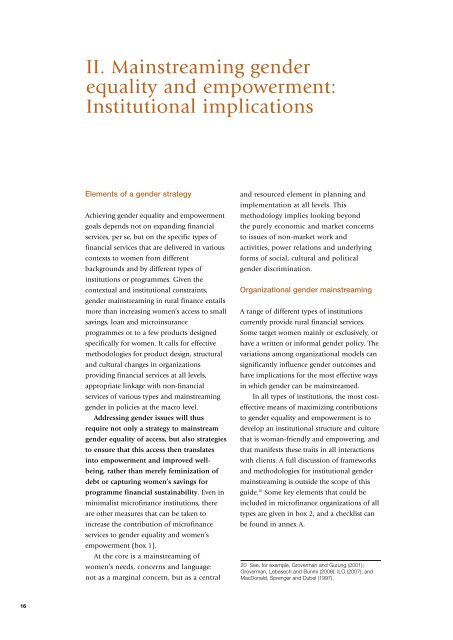Gender and rural microfinance: Reaching and empowering ... - IFAD
Gender and rural microfinance: Reaching and empowering ... - IFAD
Gender and rural microfinance: Reaching and empowering ... - IFAD
Create successful ePaper yourself
Turn your PDF publications into a flip-book with our unique Google optimized e-Paper software.
II. Mainstreaming gender<br />
equality <strong>and</strong> empowerment:<br />
Institutional implications<br />
Elements of a gender strategy<br />
Achieving gender equality <strong>and</strong> empowerment<br />
goals depends not on exp<strong>and</strong>ing financial<br />
services, per se, but on the specific types of<br />
financial services that are delivered in various<br />
contexts to women from different<br />
backgrounds <strong>and</strong> by different types of<br />
institutions or programmes. Given the<br />
contextual <strong>and</strong> institutional constraints,<br />
gender mainstreaming in <strong>rural</strong> finance entails<br />
more than increasing women’s access to small<br />
savings, loan <strong>and</strong> microinsurance<br />
programmes or to a few products designed<br />
specifically for women. It calls for effective<br />
methodologies for product design, structural<br />
<strong>and</strong> cultural changes in organizations<br />
providing financial services at all levels,<br />
appropriate linkage with non-financial<br />
services of various types <strong>and</strong> mainstreaming<br />
gender in policies at the macro level.<br />
Addressing gender issues will thus<br />
require not only a strategy to mainstream<br />
gender equality of access, but also strategies<br />
to ensure that this access then translates<br />
into empowerment <strong>and</strong> improved wellbeing,<br />
rather than merely feminization of<br />
debt or capturing women’s savings for<br />
programme financial sustainability. Even in<br />
minimalist <strong>microfinance</strong> institutions, there<br />
are other measures that can be taken to<br />
increase the contribution of <strong>microfinance</strong><br />
services to gender equality <strong>and</strong> women’s<br />
empowerment (box 1).<br />
At the core is a mainstreaming of<br />
women’s needs, concerns <strong>and</strong> language:<br />
not as a marginal concern, but as a central<br />
<strong>and</strong> resourced element in planning <strong>and</strong><br />
implementation at all levels. This<br />
methodology implies looking beyond<br />
the purely economic <strong>and</strong> market concerns<br />
to issues of non-market work <strong>and</strong><br />
activities, power relations <strong>and</strong> underlying<br />
forms of social, cultural <strong>and</strong> political<br />
gender discrimination.<br />
Organizational gender mainstreaming<br />
A range of different types of institutions<br />
currently provide <strong>rural</strong> financial services.<br />
Some target women mainly or exclusively, or<br />
have a written or informal gender policy. The<br />
variations among organizational models can<br />
significantly influence gender outcomes <strong>and</strong><br />
have implications for the most effective ways<br />
in which gender can be mainstreamed.<br />
In all types of institutions, the most costeffective<br />
means of maximizing contributions<br />
to gender equality <strong>and</strong> empowerment is to<br />
develop an institutional structure <strong>and</strong> culture<br />
that is woman-friendly <strong>and</strong> <strong>empowering</strong>, <strong>and</strong><br />
that manifests these traits in all interactions<br />
with clients. A full discussion of frameworks<br />
<strong>and</strong> methodologies for institutional gender<br />
mainstreaming is outside the scope of this<br />
guide. 20 Some key elements that could be<br />
included in <strong>microfinance</strong> organizations of all<br />
types are given in box 2, <strong>and</strong> a checklist can<br />
be found in annex A.<br />
20 See, for example, Groverman <strong>and</strong> Gurung (2001);<br />
Groverman, Lebesech <strong>and</strong> Bunmi (2008); ILO (2007); <strong>and</strong><br />
MacDonald, Sprenger <strong>and</strong> Dubel (1997).<br />
16

















